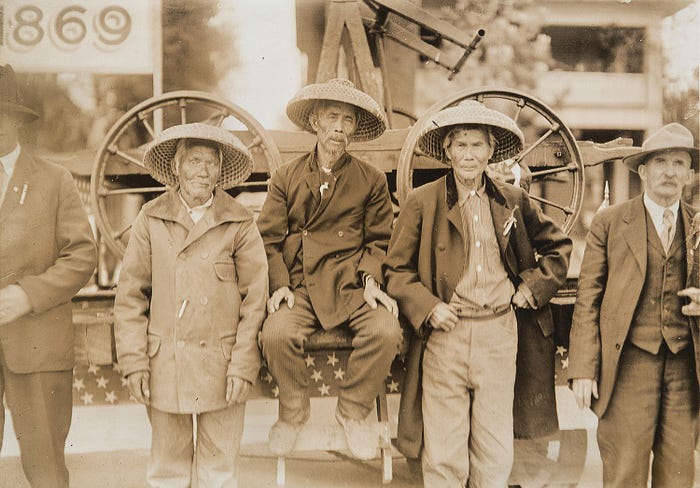150 Years Later and the Forgotten History of the Transcontinental Railroad

On May 10, 1869, the transcontinental railroad was officially completed, marking a significant moment in American history. As the United States was financially recovering from the Civil War, the transcontinental railroad dramatically improved trade and business. Most importantly, by connecting the east coast to the west coast, it was seen as symbolically (and literally) connecting the country together. While many celebrate the railroad’s benefits for the country, many Americans do not know that the railroad could not have been constructed without the labor of Chinese immigrants.
The transcontinental railroad marked the construction and joining of the Union Pacific railroad and the Central Pacific railroad. The Central Pacific railroad started its construction in Sacramento, CA on the backs of up to 20,000 Chinese immigrants — almost 90% of the railroad’s entire labor force. Chinese laborers were not the first choice of the railroad financers, but after failed attempts to attract white laborers (many of whom would stay for short periods of time due to the high-risk nature of the work), they turned to Chinese immigrants to do the deadly work required.
Anti-Chinese sentiment was overwhelming during this time. Chinese immigrants, who had largely come to California around the Gold Rush, were viewed as outsiders, foreigners who were desperate for work, and physically and emotionally weak. This racism was so pervasive that the State of California and local governments passed anti-Chinese laws to deny Chinese workers their civil rights.
Without any other viable option, Chinese immigrants joined the transcontinental railroad construction effort. Their accomplishments while working on the railroad are nothing short of impressive. Chinese laborers performed work by hand that is typically performed by big machinery in the present day. They dug tunnels and constructed retaining walls, and even planted explosives when necessary, risking their lives in hopes that they were pulled up in time.
Despite the fact they performed the most dangerous tasks, they were paid 30% less than their white co-laborers without board. In considering Chinese laborers’ life-threatening tasks alongside grueling weather, it is no wonder that there are estimates of over 1,000 Chinese laborers dying while working on the railroad. In the face of all these challenges and risks, the laborers pressed on and delivered.
However, there was only so much abuse that the laborers could withstand. In June 1867, the Chinese laborers showed their strength by organizing and protesting for their rights. They stopped working, demanding better pay and better working conditions. For eight days, they held their ground. It was one of the largest workers’ rights strikes of the era.

The hard work of these Chinese laborers is not acknowledged enough. Their contributions to the country are immeasurable. Yet, the recognition for this sacrifice goes little beyond sentences in a history textbook. Only through the work of the descendants of these workers and other community leaders has the memory of this tremendous history been kept alive.
After the completion of the transcontinental railroad, some Chinese laborers continued to work on railroads across the country while many tried to find other jobs. But in the decades after the completion of the railroad, racism and racial hostility heightened across the country. The Chinese were targets of violence and blamed for stealing jobs from white Americans. This hostility culminated to the Chinese Exclusion Act of 1882, which barred all immigration from China into the U.S. and prevented Chinese workers from working on government projects. The ban effectively lasted until the Immigration and Nationality Act of 1965 when all quotas on immigration were lifted.
Unfortunately, Asian Americans and other communities of color continue to be the targets of xenophobic sentiment and anti-immigrant policymaking. Xenophobia fueled the internment of Japanese Americans during World War II and the murder of Vincent Chin. Recent examples of anti-immigrant policies include the RAISE Act, which sought to limit family-based immigration, the main avenue in which many Asian Americans have come to the United States. Further, the current Administration has also separated immigrant families at our southern border and through deportations of Southeast Asian refugees. They have also proposed a policy that would make it difficult for immigrants who use public benefits to obtain a green card, forcing them to choose between feeding themselves and getting a green card. Anti-immigrant sentiment and policies have been part of this country’s history. This sentiment will not end until we recognize that immigrants are our friends, family, and neighbors. They have contributed and will continue to contribute to the country’s spirit, history, and culture.
As we continue to celebrate Asian American Pacific Islander Heritage Month, let us never forget about the contributions of the 20,000 Chinese laborers, how essential their work was to reinvigorate the United States and bring the country together through a connected path between the east and west coast. The railroad a key part of our community’s stake in this country’s history. Let us continue to uplift the tremendous contributions that immigrants have made in growing our nation into what it is today.
